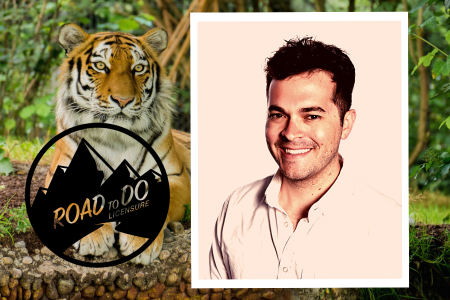David Shumway is not only a member of the Advisory Panel for the Core Competency Capstone for DOs (C3DO) project but also is entering his third year as an active duty internal medicine resident at Keesler Air Force Base in Biloxi, Miss. He has been on the American Osteopathic Association’s Bureau of Emerging Leaders for the past two years and is a columnist for The DO. He currently lives in Mississippi with his wife and 3-year-old daughter and has a son on the way.

Why did you decide to choose osteopathic medicine as a profession? Tell us your story and about your experience in the military.
I took time off after undergrad to work at Walt Disney World in Orlando for a year, which is where I met my wife. While working at Disney, I found I’d learned a lot of things that are applicable to osteopathic medicine.
After that, I spent a lot of time with a DO general practitioner and hospitalist at Oregon State. I learned all about osteopathic medicine and the body, mind, and spirit connection from him. It was because of that I knew I wanted to go into medicine. On top of that, I knew I wanted to do military medicine because my father was a Navy pilot and I spent part of my childhood living on military bases. I saw a lot of potential benefits in caring for our active duty population using an osteopathic approach and osteopathic manipulative treatment (OMT). I’ve been really lucky to be trained in performing OMT, and to see its effectiveness, especially with our active-duty youth who often have overuse and musculoskeletal injuries.
I went to AT Still University in Arizona and spent three years in Hilton Head, SC. I did all my clinicals at a big county hospital where a lot of times it was just me and the attending, so I got a lot of one-on-one teaching. In residency, I spend about one-third of my time at a large, academic, allopathic medical center, and the other two-thirds on the Air Force base. After seeing what a traditional allopathic medical hierarchy is like, I am really thankful for the experience I got in osteopathic medical school because I had that one-on-one contact, allowing me to be better prepared to be a future physician.
Having been one of the last osteopathic medical students to take COMLEX Level 2-PE, why do you feel that clinical skills should have a national standard and be assessed for competency?
I petitioned my school to take COMLEX Level 2-PE early because of my schedule and busier clinical rotations. So as luck would have it, I ended up taking it in January of 2020 while the vast majority of my classmates would have been scheduled to take it later in the year. They did not, due to the pandemic.
I learned a standardized, systematic way of approaching patients—interview, history, physical exam—to prepare for the Level 2-PE. So whatever replaces that exam needs to include a rigorous and structured review of all of those concepts.
Ultimately, the mission of the NBOME is to protect the public. Part of that is having a national standard for all to demonstrate skill in physical exam and history-taking. These are the bedrock and most foundational and fundamental skills that we have as physicians, especially when taking osteopathic distinctiveness into account. We learn to diagnose with our hands. Knowing what doesn’t feel right and what the body is supposed to feel like really helps us detect if there is anything wrong, allowing us to practice medicine in a better way. Therefore, I think, in terms of our osteopathic distinctiveness, having a national standard is very important in keeping our professional identity.
How did preparing for Level 2-PE help build the foundation for your clinical exam skills that you have carried to residency?

I prepared for the Level 2-PE with a binder full of sample cases from my university and a bunch of notes on a systematic standardized physical exam and interview that would help me approach the cases. I set up my little folding massage table in my living room and I spent weeks practicing these cases on my wife, my neighbors, and anyone who would volunteer to be a standardized patient for me. This was a perfect opportunity for me to reestablish how to approach patient care in a systematic way that I now continue to use as the foundation for everyone I see.
What are your hopes for the C3DO pilot for the future of the osteopathic profession?
I hope we are able to replicate the experience that I had, which required me to demonstrate competency in osteopathic clinical skills, necessitating that I prepare for it thoroughly and hone those skills before graduation.
There is no form of military training in the United States that I know of that doesn’t end with some type of crucible to prove yourself. It’s meant to bake in the skills that you’ve learned, and without that—without that impetus that requires you to solidify clinical skills—you wouldn’t take it as seriously or learn as much. A tiny, manageable amount of stress is a strong motivator that encodes memories better. When you’re under strain, evolutionarily, your brain is programmed to remember the time you saw the tiger in the bush. Every time you see that bush in the future, you will remember it well.
I think an assessment can be developed to create those conditions that make you want to prepare yourself. So long as the exam maintains that higher level of aptitude in clinical skills, history-taking, and clinical documentation, I think that’s very important for the continuation of our profession as a whole.

